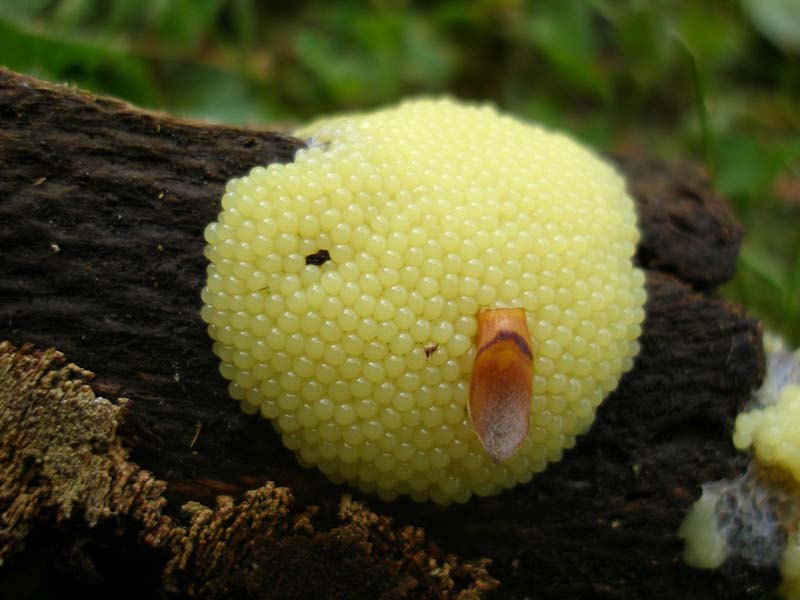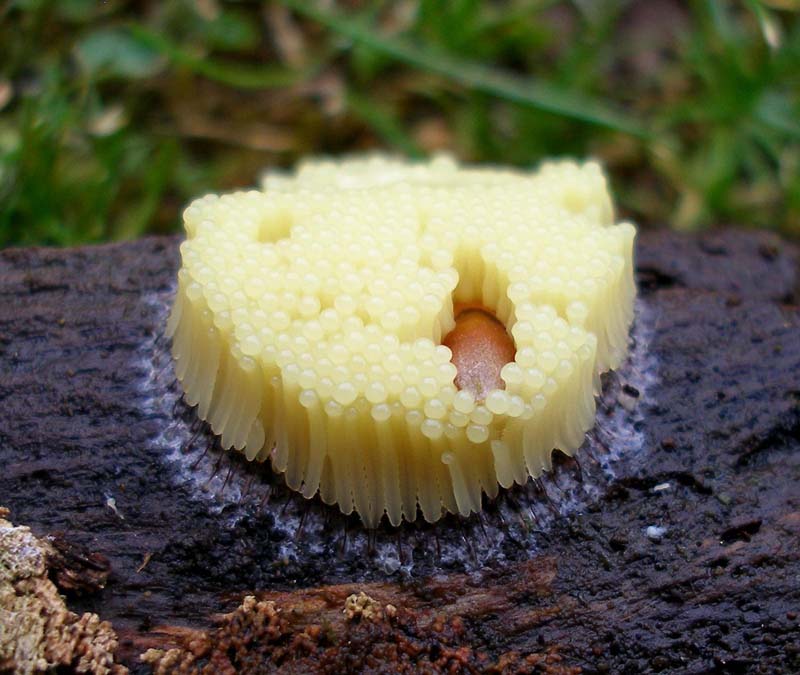Articles
Articles supplied by members are their own work and this Society does not necessarily endorse their views.
| Title | Author |
| An unintentional fungus foray | Andrew and Lisa Dodd |
| The strange case of the ice making fungus | John Tyler |
| Smells and fungi - the answers | Penny Cullington |
| 40 hours in the life of a slime mould | Penny Cullington |
| There’s edible fungi about at the moment! | Penny Cullington |
| Hericium erinaceus on Naphill Common | Peter Davis |
"The amazing development of a slime mould (Myxomycete) recorded over the space of just 40 hours."
Article and images © Penny Cullington

This is the slime mould Stemonitis flavogenita at the plasmodium stage, as I collected it one afternoon, with a beechnut husk sitting on the surface. This gives a sense of scale and also serves to show how the slime mould develops as the husk gradually becomes submerged. It’s at this ‘plasmodium’ stage that one can see why these extraordinary organisms are called ‘slime moulds’. (They’re not in fact true fungi at all!) Plasmodium is usually white, in a few species like this one it’s yellow, and in a few it’s really bright orange or pink. So look out for splodges of bright paint on rotten wood, and further investigation might reveal you’ve found one of these amazing organisms at its ‘slimy’ stage!

S. flavogenita four hours later, with transformation into the typical pipe-cleaner shape of this species already well under way. The husk, now partially submerged, shows how the proportions and height are changing.

S. flavogenita another 4 hours on (now midnight) with the ‘pipe-cleaners’ now very obvious and the yellow colour just beginning to darken, also droplets of moisture being exuded as it begins to dry out.

S. flavogenita first thing next morning, now fully developed though still no more than one centimeter tall, and with no signs of yellow ‘slime’ left. The by now very dark brown surface is shiny from the moisture still being retained.

S. flavogenita later that morning, showing the husk by now well and truly surrounded and the drying out process just visible at the base where the ‘pipe-cleaners’ are beginning to fade a little.

S. flavogenita that evening, now much drier with the typical cocoa-brown of the mature stage reaching to about halfway up.

S. flavogenita the following morning, now fully dried off and mature but clearly having suffered from a slimy visitor in the night! Slugs and snails love to eat slime moulds at the plasmodium stage but this one arrived just too late so continued on its way, though obviously the fly now visible on the top is firmly trapped in the snail trail. Each individual pipe-cleaner head now comprises a mass of fine powder, this being the millions of microscopic spores now ready to be dispersed by air movement, rain drops, or any little creature which chooses to devour them, thus inadvertently setting this whole incredible process in motion all over again!
THERE'S EDIBLE FUNGI ABOUT AT THE MOMENT!
Article and images © Penny Cullington
It’s getting towards the end of July, and if you are interested in collecting for the pot as I am, it’s worth keeping a look-out for mushrooms now. There are two species fruiting at the moment: the very common Field Mushroom, Agaricus campestris, and the much larger and less common Horse Mushroom, Agaricus arvensis. Both grow in grassy places. If you are not so familiar with this last species, you need to be careful about identification as it could possibly be confused with the Yellow Stainer, Agaricus xanthodermus or even some species of Amanita. Coming soon in our latest Newsletter is more help on how to identify all these species, but if in doubt whether you have an Agaricus or an Amanita Derek's advice is to put the caps (minus the attached ring) gills-down on a white plate, cover and leave for a few hours to make sure the spores are brown and not white. A. arvensis lacks the clearly pink gills of other species of mushroom when young, so can be confused with the genus Amanita which has white gills.) To identify the Yellow Stainer (which causes gastric upsets) pick away a little piece of flesh from the very base of the stem (where it touched the earth); if it turns bright chrome yellow, don't eat it! See the two photos below.
Enjoy, but be careful! Better safe than sorry!

The Field Mushroom, Agaricus arvensis, showing a variety of young and old specimens. Note the base of one has gone brownish but not bright chrome yellow as in the Yellow Stainer. The caps and the side of the stem can look slightly yellow-tinged where handled.

The Yellow Stainer, Agaricus xanthodermus, showing the instant chrome yellow staining where the flesh is revealed at the very base of the stem.

